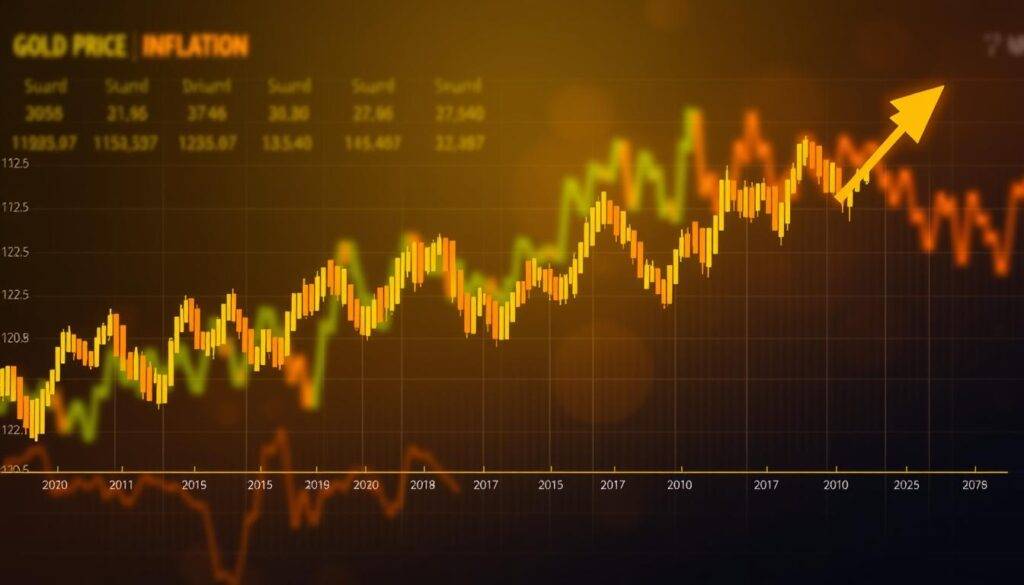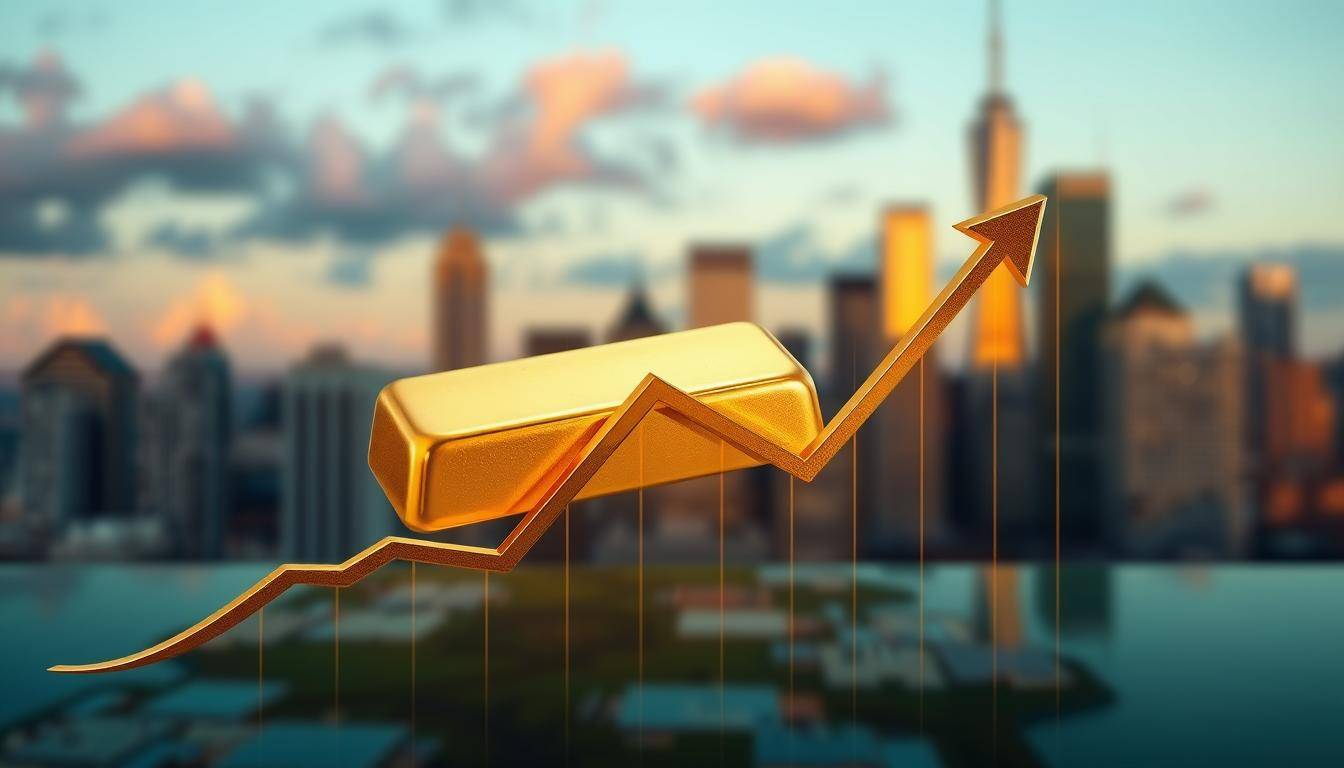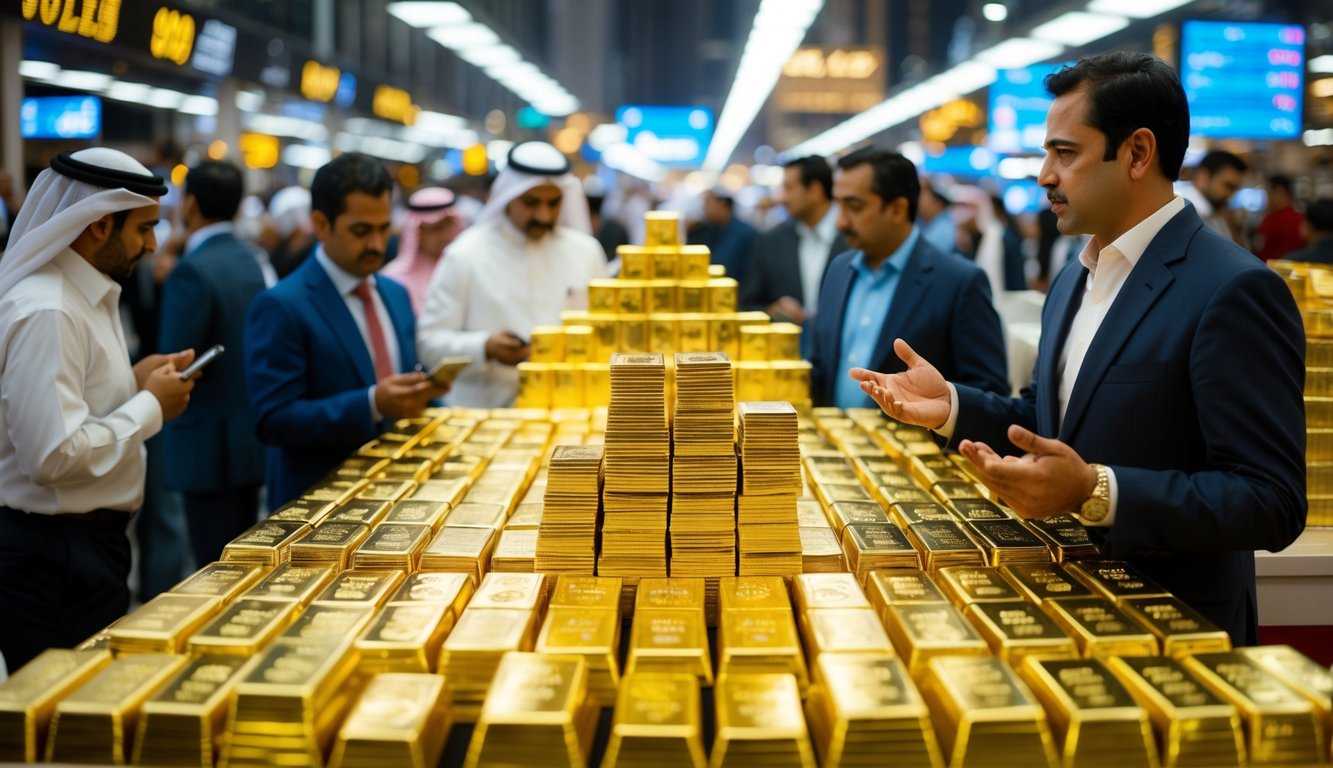Did you know gold made almost a 35% return in the 1970s when inflation was high? This shows gold’s power as a shield against inflation. Its why investors are so interested in it today.
Understanding how inflation affects gold prices is key in today’s economy. The Consumer Price Index (CPI) rose 4% in May. This is down from a peak over 9% last June. Investors are watching gold prices closely.
Investing in gold during inflation has been a way to keep wealth safe. The gold rate today shows this, with a 14% increase from November 2022 to 2023. This rise is no surprise to those who follow the forex market. They know gold is a safe haven in uncertain times.
Gold prices change for many reasons. These include inflation rates, the U.S. dollar’s strength, and what the Federal Reserve does. With gold possibly hitting new highs soon, investors are keeping a close eye on it.
Key Takeaways
- Gold generated a 35% annual return during high inflation in the 1970s
- The Consumer Price Index rose 4% annually in May, down from over 9% last June
- Gold prices rebounded 14% between November 2022 and 2023
- Experts predict potential new all-time highs for gold prices
- Gold is often viewed as a hedge against inflation and economic uncertainty
Understanding the Relationship Between Gold and Inflation
Gold is often seen as a safe choice against inflation. We’ll look at its history, how inflation affects money, and how gold keeps wealth safe.
Historical Perspective on Gold as a Hedge
Gold has been a trusted shield against inflation for a long time. In the 1970s, when prices went up fast, gold prices also climbed. This showed its power in keeping wealth safe.
How Inflation Impacts Currency Value
Inflation makes money worth less. The U.S. Federal Reserve aims for a 2% inflation rate. If inflation goes over this, the dollar’s value drops. This makes gold more appealing to investors.
Gold’s Role in Preserving Wealth
Gold stays valuable when prices rise. It’s a favorite for keeping wealth safe. Experts say put 5%-10% of your money in gold. This mix can shield against inflation’s effects on gold markets.
| Inflation Rate | Gold Price Performance | Dollar Value |
|---|---|---|
| Low (0-2%) | Stable | Strong |
| Moderate (2-5%) | Gradual Increase | Weakening |
| High (5%+) | Sharp Increase | Weak |
It’s key for investors to understand gold and inflation. Knowing about inflation rates, money values, and gold’s stability helps make smart choices. This way, investors can wisely add gold to their portfolios.
Current Economic Landscape and Gold Prices
The economic world is changing, and gold prices are moving with it. Our analysis shows gold prices hitting new highs in recent months. Experts think they could even reach $3,000 per ounce. In September 2024, gold reached a record of $2,672 per ounce, showing its growing value in uncertain times.

The Federal Reserve’s moves are key in this shift. With inflation at a three-year low, near the Fed’s 2% goal, experts predict more interest rate cuts. These cuts make gold more appealing since it doesn’t earn interest.
Financial advisors suggest putting 10% of growth investments in precious metals like gold. This advice fits with current market trends. Investors are turning to gold for stability, even as oil and index analysis offer insights.
Investors should look at gold as a long-term investment, lasting 10 years or more. Using dollar-cost averaging can help smooth out price swings. Even with high prices, buying gold now could pay off in the long run.
As the economy changes, bitcoin analysis also plays a role in investment choices. But gold remains a top choice for its safe-haven status, even in uncertain times.
Inflation’s Effect on Gold Prices: What Investors Need to Know
Gold prices have seen big changes over the last ten years. This shows how inflation and gold investments are linked. It’s important for investors to know this to make smart choices.
Short-term Price Fluctuations
In early September 2024, gold prices hit a record high of over $2,500 per ounce. This rise happened when inflation rates changed. The Bureau of Labor Statistics said inflation dropped to 2.5%, near the Federal Reserve’s goal.
These quick price changes show how gold prices react to economic signs and market feelings.
Long-term Trends in Gold Prices During Inflationary Periods
Gold has done well when inflation is high. For example, in the 1970s to 1980s, gold prices went from $35 to $850 per ounce. Recently, while the S&P 500 fell by about 57% from October 2007 to March 2009, gold prices went up by 25.5%.
This shows gold can be a good protection against inflation.
Factors Influencing Gold Price Sensitivity to Inflation
Several things make gold prices sensitive to inflation:
- Currency devaluation: Inflation can make currencies weaker, making gold more valuable.
- Investor sentiment: People’s hopes for future inflation can increase gold demand, even if inflation doesn’t happen.
- Central bank policies: In 2022 and 2023, global central banks bought a lot of gold, affecting the market.
- Supply and demand: Gold mine production stays around 3,000 metric tons a year. Demand changes with the economy.
As we face today’s economic challenges, knowing how inflation affects gold investments is crucial. It helps investors make their portfolios better in uncertain times.
Central Banks’ Gold Reserves and Market Impact
Central banks are key players in the gold market. Their gold buying or selling can change gold prices and demand. Let’s look at recent trends and how they affect global gold markets.
Recent Trends in Central Bank Gold Purchases
Central banks have been buying a lot of gold. In 2023, they bought 1,037 tonnes. This buying continued into 2024, with 290 tonnes in the first quarter.
China was the biggest buyer in 2023. They bought a record amount of gold. You can read more about this at this link.

Top Gold-Buying Countries
Some countries have increased their gold reserves a lot:
- China
- Poland
- Czech Republic
- Singapore
The United States has the most gold, over 8,000 tonnes. Germany, Italy, and France also have a lot. This affects gold prices worldwide, including in the UAE, Dubai, and Saudi Arabia.
Implications for Global Gold Demand
Central bank buying has big effects on the gold market:
| Year | Projected Average Gold Price | Estimated Central Bank Purchases |
|---|---|---|
| 2024 | $2,500/oz (Q4) | 850 tonnes |
| 2025 | $2,600/oz | To be determined |
These numbers look good for gold prices. With central banks buying more, demand and prices might keep going up.
Gold as a Safe-Haven Asset During Economic Uncertainty
Gold is often seen as a safe place to put money when the economy is shaky. Recently, gold hit a record high of over $1,600 per troy ounce. This shows its value during times of trouble and rising prices. It also highlights gold’s role in shaping financial markets.
Over the last 100 years, gold has given investors an average return of 2.1% each year. While this is less than the Dow Jones Industrial Average’s 7.3%, gold has done better in 43% of the years since 1925. In bad economic times, gold usually does better than the Dow Jones by 1.65% over two years.
Gold trading has grown a lot lately. Micro Gold futures trading saw a 27% increase in volume by Q2 2024. This shows gold’s lasting appeal as a safe choice when the economy is uncertain.
“Gold prices soared approximately 100% from about $350 per ounce in early 2003 to over $700 per ounce by mid-2006 during a period of falling interest rates, stable economic growth, and rising inflation.”
When the economy is unstable, people often choose gold. This was true during the 2008 Global Financial Crisis. Gold prices went from around $700 per ounce in late 2007 to over $1,000 per ounce by early 2009. They even reached nearly $1,900 per ounce by 2011.
For those wanting to learn more about gold in uncertain times, there are many youtube videos. They offer detailed analysis and expert views on gold market trends.
Factors Driving Gold Demand Beyond Inflation
Gold price trends are shaped by more than just inflation. We’ll look at the main factors that drive its demand.
Jewelry and Industrial Demand
Jewelry is a big player in gold demand, making up 44% in the first half of 2022. Countries like India, China, and the United States are the biggest consumers. The tech sector also uses gold, for 7.5% of demand, in medical devices and electronics.

Investment Demand through ETFs
Exchange-traded funds (ETFs) let people invest in gold without owning it. They’re key during inflation. ETFs and mutual funds make it easy to add gold to your portfolio, helping with diversification and risk management.
Geopolitical Influences on Gold Prices
Geopolitical tensions affect gold prices a lot. Central banks, especially in the U.S., Germany, Italy, France, and China, play a big role. Their gold reserves and policies can quickly change the market’s view of gold.
| Factor | Impact on Gold Demand |
|---|---|
| Jewelry | 44% of demand (H1 2022) |
| Technology | 7.5% of demand |
| Central Bank Reserves | Significant market influence |
| ETFs | Growing investment vehicle |
Knowing these factors is key when thinking about investing in gold. Gold is not just a hedge against inflation. Its demand is influenced by many things, like the global economy, tech, and world events.
Gold Production and Supply Dynamics
Gold production is key in setting the gold rate today. Mining is the main source of global gold supply. In recent years, gold production has averaged about 3,000 metric tons, hitting a high of 3,545 tons in 2018.
Big players in gold production include China, Russia, Australia, the United States, and Canada. Their output greatly affects the global gold market. For example, China’s gold production is influenced by government policies and operational challenges, impacting global supply and demand.
- Exploration and prospecting using advanced techniques
- Mine development and infrastructure construction
- Extraction through crushing, grinding, and smelting
- Purification to obtain refined gold
Environmental worries are growing in the gold industry. Sustainability and responsible sourcing are changing production methods, costs, and prices. These changes, along with forex market analysis, make the gold production and supply scene complex.
| Factor | Impact on Gold Production |
|---|---|
| Government Policies | Can restrict or encourage production |
| Operational Challenges | May lead to supply disruptions |
| Environmental Concerns | Influence production methods and costs |
| Technological Advancements | Improve extraction efficiency |
Strategies for Investing in Gold During Inflationary Periods
Investing in gold during inflation needs careful thought and planning. Understanding inflation’s impact on gold prices is key. It’s important to know the different ways to invest and when to do it.
Physical Gold vs. Gold-Backed Securities
Investors can pick between physical gold and gold-backed securities. Physical gold gives you real ownership but raises concerns about storage and security. On the other hand, gold-backed securities like ETFs are easier to trade and cost less to store.
Gold demand rose by 12% in the first half of 2022. This shows more people are interested in gold across different areas.
Timing Considerations for Gold Investments
Timing is key when investing in gold. Gold prices can swing wildly in the short term but usually hold their value over time. From November 2022 to February 2023, gold prices went up by 14%.
Meanwhile, assets like Bitcoin saw big drops during the same period.
Portfolio Allocation Recommendations
Experts suggest keeping gold to no more than 10% of your total investments. This helps spread out risk because gold doesn’t move in sync with stocks and bonds. In Q3 of 2022, global gold demand jumped by 28%.
“Gold often performs well during economic and geopolitical uncertainties, serving as a store of value in times of market volatility.”
Gold’s role as a hedge and diversifier is still important, even if its price moves unpredictably during inflation. Investors should think about their risk level and financial goals before adding gold to their portfolios.
Conclusion
Gold remains a key player in the financial world. Its history as a shield against inflation is still important today. Prices have jumped from $35 an ounce in the 1970s to over $2,650 now. This shows gold’s lasting value.
Gold’s value can swing, but it’s a great mix for your investments. The recent jump in gold prices shows it’s a safe place to put money. With the Federal Reserve planning to lower interest rates, gold looks even better.
Gold doesn’t earn income like stocks or bonds do. But, it’s unmatched in keeping wealth safe during tough times. As the economy shifts, knowing gold’s role in fighting inflation is crucial for investors. It helps protect and grow wealth.
FAQ
How does inflation impact the price of gold?
Inflation makes money worth less, so people buy gold. Gold is seen as a safe place to keep money when times are tough. This makes its price go up.
Is gold a good long-term investment during inflationary periods?
Yes, gold has kept its value well over time, even when inflation is high. It’s a real asset that helps protect against losing money in paper currencies.
What factors influence the relationship between gold prices and inflation?
Many things affect gold prices, like what central banks do and interest rates. The stock market, world events, and how much gold is mined also play a part. Expectations of inflation and uncertainty in the economy are important too.
How do central bank gold reserves impact global gold prices?
Central banks buying more gold increases demand and can push prices up. Countries like China, India, and Türkiye have a big impact on the market.
What are some strategies for investing in gold during inflationary times?
You can buy physical gold, like coins or bars, or invest in gold ETFs. Gold mining stocks are another option. It’s important to know when to invest and how much to put in gold, with a max of 10% recommended.
How does gold perform as a safe-haven asset during economic uncertainty?
Gold is seen as a safe place to keep money when markets are shaky. It keeps its value well, even when other investments don’t. This makes it a good choice for diversifying your portfolio.




